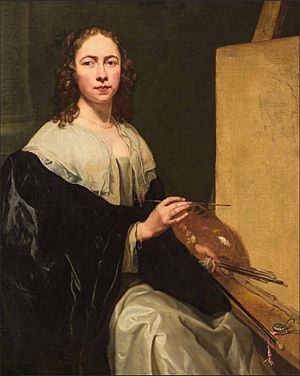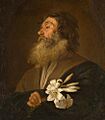Michaelina Wautier facts for kids
Michaelina Wautier (1604–1689) was a talented painter from the Southern Netherlands, which is now parts of Belgium and the Netherlands. For a long time, her amazing paintings were thought to be done by male artists, even her own brother Charles. But in the 2000s, people finally realized she was an incredible female artist from the Baroque period.
Michaelina was special because she painted many different things. This was unusual for women artists back then. Most female painters were only allowed to create smaller artworks, like portraits or still-life paintings.
Contents
About Michaelina Wautier
Michaelina Wautier was born in 1604 in Mons, Belgium. She was the only daughter in a family of nine children. Experts believe her family was wealthy. This is because her paintings show she knew a lot about old myths and symbols.
Early Life and Career
It seems Michaelina started her art career later in life, around age 39. However, her talent was quickly noticed. Her brother Charles was an army officer. Perhaps through his connections, she was asked to paint a portrait of a famous general, Andrea Cantelmo. This painting is now missing, but we know it existed from an old drawing of it.
In 1645, Michaelina and Charles moved to Brussels. They both stayed unmarried and shared an art studio. They lived in a large house near the Chapel Church. Both Michaelina and Charles were also involved in business, especially buying and selling property.
Art Training and Mystery
It's almost certain that both Michaelina and Charles had excellent art training. However, no one knows where or with whom they studied. Not much else is known about Michaelina's life. Most of what we know comes from what experts guess by looking at her artworks.
Michaelina's Artworks
Michaelina Wautier painted both small and very large pictures. Her main subjects were history, religion, and mythology. At that time, big paintings were usually only done by male artists. Michaelina also created many scenes of everyday life and detailed flower paintings. She also painted a series of portraits. Her wide range of subjects and painting sizes made her stand out from other artists.
Famous Self-Portrait
Her first self-portrait, painted in 1649, was mistakenly thought to be by the Italian painter Artemisia Gentileschi for many years. This painting is still one of Michaelina's most famous works. It was even included in a 1905 book called Women Painters of the World. It wasn't until 1672 that another artist, Elisabeth-Sophie Chéron, created what is seen as the first self-portrait by a woman in France.
The Triumph of Bacchus
The painting called The Triumph of Bacchus (1650) is often named as one of her most important works. It is now in the Kunsthistorisches Museum in Vienna. Michaelina was skilled at painting human figures. She even included herself in the colorful crowd of this painting. She is the only person in the picture who looks directly at the viewer. The large size of this painting was also very unusual for a female artist of her time. People thought women couldn't create such big, complex artworks.
Recognition and Forgetting
Unlike many other women painters of her time, Michaelina Wautier was recognized during her lifetime. She even sold four paintings to Archduke Leopold Wilhelm of Austria for his art collection. These paintings are mentioned in a list of his collection from 1659.
However, after her death, her work was largely forgotten. Some art historians believe this happened because her paintings were wrongly given to other male artists, like Thomas Willeboirts Bosschaert, Jacob van Oost, or her brother Charles Wautier. Also, Michaelina stopped painting around 1659 but lived until 1689, when she was 85. This long break meant she wasn't creating new art or staying in the public eye.
Unlike some other famous female artists, her self-portrait was never made into a print. This meant her memory wasn't kept alive easily. In fact, even her own self-portrait was later thought to be by another artist, Artemisia Gentileschi.
Michaelina's Legacy
After Michaelina Wautier died in 1689, her artistic legacy was quickly lost. This was due to her paintings being wrongly credited to others, confusion with other female artists, and people not being able to tell her work apart from her brother Charles's.
Rediscovery of Her Work
Two centuries later, starting in the 1850s, people began to recognize her work again. However, she was usually only called a "skilled portraitist" with few known works. Her reputation grew more in the 1960s. This happened when her flower painting Garland with a Butterfly was shown in an exhibition. Also, in 1967, she was officially recognized as the true artist of The Triumph of Bacchus.
The writer and feminist Germaine Greer helped make Wautier more famous in her 1979 book, The Obstacle Race: The Fortunes of Women Painters and Their Work. Greer said that Wautier's painting Portrait of a Commander in the Spanish Army showed "swiftness and accuracy." This meant Michaelina had a lot of professional practice. More of her artworks were correctly identified and included in exhibitions. This helped more people interested in art learn about her. The growing interest in her work led to her first special exhibition in 2018.
Retrospective Exhibition
From June to September 2018, the first full exhibition of Michaelina Wautier's work was held. It was shown at the Museum aan de Stroom in Antwerp (MAS). The Rubenshuis also helped organize this event. The exhibition was put together by the art historian Katlijne Van der Stighelen.
Images for kids









